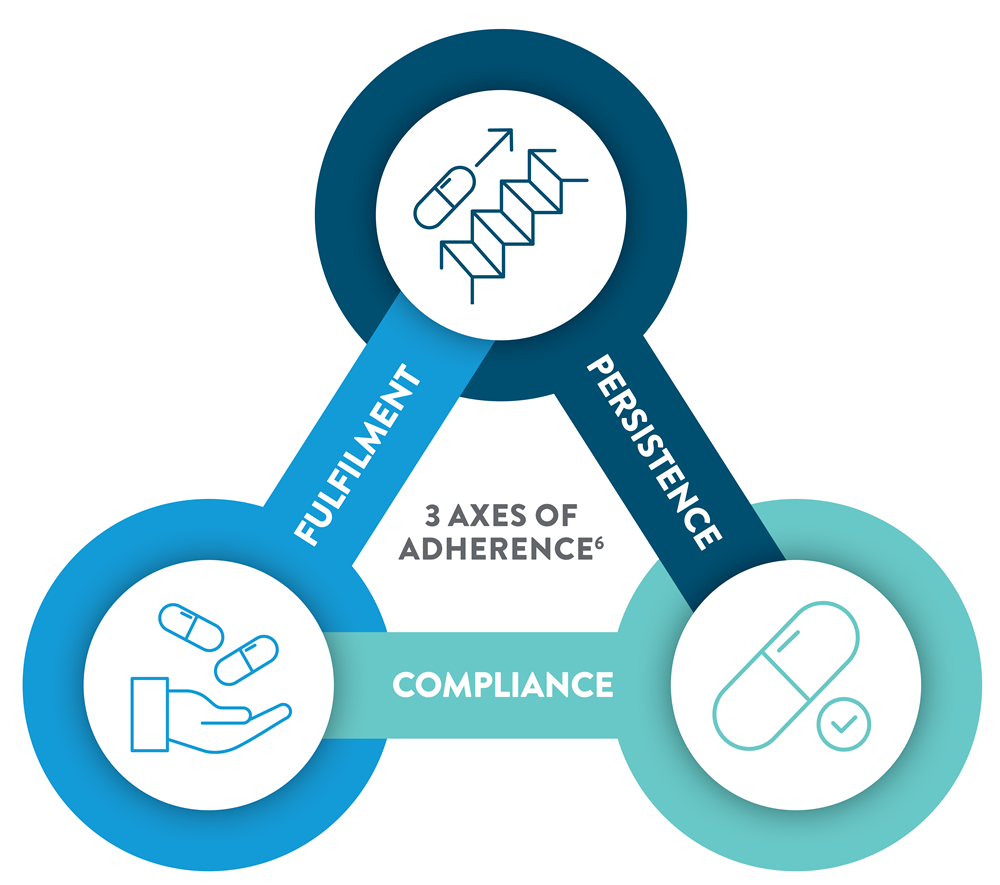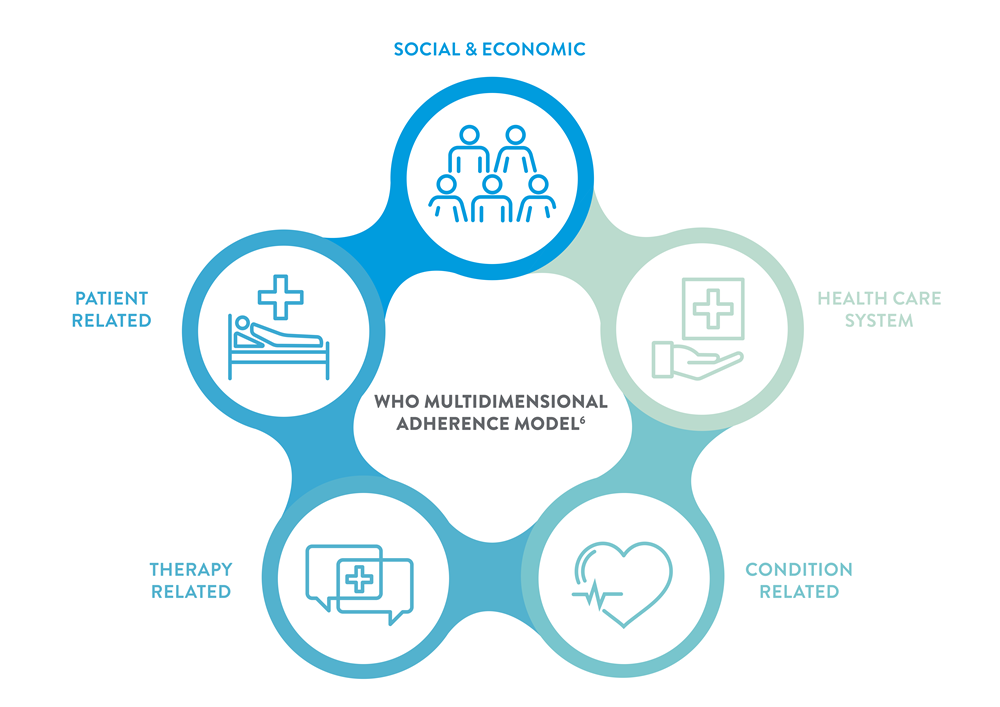
Adherence & Behavioral Science

Adherence – or the way patients follow and keep up with medical treatments, is an important aspect to improve the health of the overall population. At Abbott, we are taking a unique approach to improving adherence, so that we can help patients live better.
Despite numerous medical advances and new medicine launches, control over various chronic diseases has not improved, driven primarily by non-adherence to treatments 1,2
of patients never fill their
first prescription.3,4
of patients do not take
their treatments as directed.5
of patients stop their
treatments earlier than recommended.4
Non-adherence has a devastating social and economic impact

200K
Poor adherence contributes to 200,000 premature deaths in Europe per year.4

125 Bn
125 billion euro per year in excess healthcare services in Europe, and in the US 105 billion USD per year in avoidable hospitalizations alone.4
Non-adherence is a multidimensional challenge driven by varied factors including :
Patient Awareness
- Inadequate knowledge about therapy
- Poor communication with healthcare professionals6
Socio-Cultural Beliefs
- Cultural beliefs
- Fear of side-effects
- Lack of belief in treatment need6
Treatment fatigue
- Lack of visible benefit in long-term treatments
- Complex dosing schedules6
Economic Factors
- Financial worries
- Lack of access to healthcare6
Lack of access to medical care is a key healthcare challenge in emerging markets.
Concentration of healthcare resources in urban areas
83.5% of doctors in Thailand are based in urban areas7. In India 59.2% of healthcare workers are concentrated in urban areas, where only 27.8% of the population resides.8
Primary care consultations last a very short time for half the world’s population9
Time spent with a doctor is important to help explain a condition and share important treatment information.
But it is quite limited – doctors only spend 1.5 min with their patients in India, compared to 22.5 min in Sweden.9
Addressing adherence is a major step forward towards improved patient outcomes
Usually, after a diagnosis, taking a medicine is the first step on the road to better health. But a large number of patients don’t take their medicine as prescribed. Adherence is all about the extent to which patients follow medical treatment and advice.10

FULFILMENT
of a treatment means that the patient has received the medicines prescribed by the doctor 11
PERSISTENCE
of a treatment means that the patient has taken the medicine over the initially intentioned duration 11-13
COMPLIANCE
with treatment means that the patient has taken the medicines as prescribed11-13

Adherence is a behavior
Approx. 25% of patients state “forgetting” as their main reason for non-adherence.15
However, recent studies show that providing reminders are only helpful if patients are motivated to take their medicines and comply with their treatment.16
Adherence is a repeated and ongoing health behavior. If patients are not adherent, they need something to help them change their behavior. Using theory-driven, evidence-based behavioral interventions can influence patient health.
Behavioral science can help us to understand why patients do not take their treatment.
Learn more by exploring the articles and view the masterclasses.

Our unique approach to improving adherence represents a new world of educating healthcare professionals and empowering patients, driven by the intersection of behavioral science and technology.
From treating disease to treating patients


By collaborating with leading experts in the medical community, we are working together towards our common goal of improving people’s health by helping them adhere to their treatment.
- Haynes RB, Ackloo E, Sahota N, McDonald HP, Yao X. Interventions for enhancing medication adherence. Cochrane Database of Systematic Reviews 2008, Issue 2 Art. No.:CD000011. DOI: 10.1002 / 14651858.CD000011.pub3.
- Edelman SV, Polonsky WH. Type 2 Diabetes in the Real World: The Elusive Nature of Glycemic Control. Diabetes Care. 2017; 40 (11): 1425-1432. doi: 10.2337 / dc16-1974.
- Fischer MA, Stedman MR, Lii J, et al. Primary medication non-adherence: analysis of 195,930 electronic prescriptions. J Gen Intern Med. 2010; 25 (4): 284-290. doi: 10.1007 / s11606-010-1253-9
- Organisation for Economic Co-operation and Development, 2018. Http://Www.Oecd.Org/Officialdocuments/Publicdisplaydocumentpdf/?Cote=DELSA/HEA/WD/HWP(2018)2&Doclanguage=En. OECD Health Working Paper No. 105 “Investing in medication adherence improve health outcomes and health system efficiency” Adherence to medicines for diabetes, hypertension, and hyperlipidaemia.
- Brown MT, Bussell JK. Medication adherence: WHO cares?. Mayo Clin Proc. 2011;86(4):304-314. doi:10.4065/mcp.2010.0575
- World Health Organization (WHO), 2003. Adherence to long-term therapies – Evidence For Action. Available at: https://www.who.int/chp/knowledge/publications/adherence_full_report.pdf. Accessed December 2020.
- Deloitte, 2016. Healthcare For The Pre-Middle Class In Emerging Economies. [online] Available at: https://www2.deloitte.com/content/dam/Deloitte/sg/Documents/risk/sea-risk-healthcare-in-emerging-economies.pdf [Accessed 2 December 2020].
- World Health Organization (WHO), 2016. The health workforce in India – Human Resources for Health Observer Series No. 16. [online] Available at: https://www.who.int/hrh/resources/16058health_workforce_India.pdf Accessed December 2020
- Irving G, Neves AL, Dambha-Miller H, et al. International variations in primary care physician consultation time: a systematic review of 67 countries. BMJ Open. 2017; 7 (10): e017902. Published 2017 Nov 8. doi: 10.1136 / bmjopen-2017-017902.
- Kenreigh CA, Medication Adherence: A Literature Review, 2005. Available at: www.medscape.com/viewarticle/514164. Accessed December 2020.
- Jimmy B, & Jimmy J. Patient medication adherence: Measures in daily practice. Oman Medical Journal; 2011; 26(3): 155-9. 2: Abhijit S. Gadkari & Colleen A. McHorney (2010) Medication nonfulfillment rates and reasons: narrative systematic review, Current Medical Research and Opinion, 26:3, 683-705
- Cramer JA, Roy A, Burrell A, et al. Medication compliance and persistence: terminology and definitions. Value Health. 2008;11(1):44-47.
- Vrijens B, De Geest S, Hughes DA, et al. A new taxonomy for describing and defining adherence to medications. Br J Clin Pharmacol. 2012; 73 (5): 691-705. doi: 10.1111 / j.1365-2125.2012.04167.
- Bonaccorso S, Sturchio JL. Perspectives from the pharmaceutical industry. BMJ 2003; 327; 863 doi: https://doi.org/10.1136/bmj.327.7419.863
- Khan MU, Shah S, Hameed T. Barriers to and determinants of medication adherence among hypertensive patients attended National Health Service Hospital, Sunderland. J Pharm Bioallied Sci. 2014;6(2):104-108. doi:10.4103/0975-7406.129175.
- Choudhry NK, Krumme AA, Ercole PM, et al. Effect of Reminder Devices on Medication Adherence: The REMIND Randomized Clinical Trial. JAMA Intern Med. 2017;177(5):624-631. doi:10.1001/jamainternmed.2016.9627